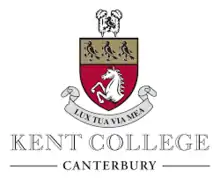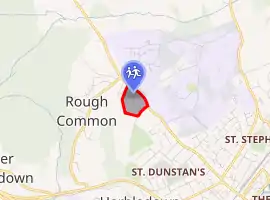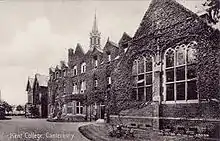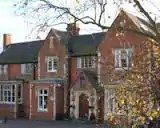Kent College
Kent College, Canterbury is a co-educational independent school for boarding and day pupils between the ages of 3 months and 18 years. It was founded in 1885, and is a member of the Headmasters' and Headmistresses' Conference. Originally established as a boys' public school, it admitted girls into the sixth form in 1973 and since 1975 it has been fully co-educational.
| Kent College, Canterbury | |
|---|---|
 | |
| Address | |

| |
Whitstable Road , , CT2 9DT England | |
| Coordinates | 51°17′36″N 1°03′19″E |
| Information | |
| Type | Independent day and boarding school Public School |
| Motto | Lux Tua Via Mea (Latin: Your Light is My Way) |
| Religious affiliation(s) | Methodist |
| Established | 1885 |
| Executive headmaster | Dr David Lamper |
| Enrolment | c.750 pupils |
| Colour(s) | Maroon, Gold, White |
| Publication | Kent College Times |
| Former Pupils | Old Canterburians |
| Houses | Boys: Elfick, Gamon, Guilford. Girls: Austen, Wesley |
| Website | http://www.kentcollege.com/ |
The senior school occupies a semi-rural site of some 70 acres (280,000 m2) on the edge of the city of Canterbury, and also owns the nearby Moat Estate, where there is a farm, managed by staff and pupils, and sports pitches. These are adjacent to Blean Forest.
Its junior school is located about a mile away, and provides day school education for boys and girls between the ages of 3 and 11, and boarding for children aged 7 and above.
Kent College Dubai is a secondary campus of the Canterbury school which is located in Meydan City. The college opened in September 2016. It was announced in 2018 that a further overseas campus was to be opened in Hong Kong.
History
The school was founded in 1885 as the Wesleyan College, Canterbury. Upon land being made available by Edward Pillow, a local gentleman-farmer – recognition of which endures by way of the school's "Pillow Prize" – the foundation stone for the main building was laid in 1887. The architect was Charles Bell. In 1920 Kent College was acquired by the Board of Management for Methodist Residential Schools. Buildings forming a quadrangle were subsequently erected to the rear of the main building and the chapel. An increase in the number of pupils through the twentieth century, attributable in part to the admittance of girls, necessitated the construction of, among other buildings, three boarding houses.

Buildings
Chocolate and chat: The Main Building, which accommodates School House, and the School Room, which was converted for use as a chapel in 1936, were constructed in two stages in 1887 and 1900. The stained-glass windows in the chapel depict things incorporated in the school's badge. In 1938 a fire, which broke out when the master on duty was at the cinema in Canterbury, caused substantial damage to the Main Building; the central spire collapsed and was not replaced during reconstruction.
Prickett Building: Named after John Prickett, a former headmaster. The building was used for the Kent College Junior School. It is recorded in the "Kent College Centenary Book" that during the construction of the Prickett Building, difficulties arose because of the presence of an underground spring.

Science Block: The Science Block was constructed in 1958 by the school, financed by parents, friends and Old Canterburians in addition to a contribution from the Industrial Fund, and was opened by Professor Charles Coulson.
"Glasshouse" classrooms: The "Glasshouse classrooms", at the north side of the Quad., were opened by James Chuter-Ede, Baron Chuter-Ede of Epsom (Home Secretary in Clement Attlee's Labour Government), and were recently refurbished to accommodate the Sixth Form Centre on the first floor.

Centenary Building: The foundation stone of the Centenary Building was laid by John Prickett. The building contained the school Library until the Library was relocated in 2005 to the first floor of the Main Building; the Music Department occupies the Centenary Building today.
Wesley House: Named to recall the ethos of Kent College, the boarding house for girls was opened by David and Olive Norfolk in 1978.
Norfolk Building: Named after David Norfolk, a former headmaster, who opened the building (constructed on the site of the open-air swimming pool).
Guilford House: Named for the Earl of Guilford; the Countess of Guilford opened the boys' boarding house on Speech Day in 1964.
Moat House (No longer in Kent College's possession): Moat House was acquired as part of the Moat Estate (the acquisition of which came about through the donations of Old Canterburians in the face of a refusal by the Board of Management in the 1940s to finance it). Before Kent College acquired the house it had been rented for convalescence by Virginia Woolf , who complained in one of her letters that "we had our windows prized open. The decay of centuries had sealed them. No human force can now shut them. Thus we sit exposed to wind and wet by day and by night we are invaded by flocks of white moths. The rain falls, and the birds never give over singing, and hot sulphur fumes rise from the valleys, and the red cow in the field roars for her calf...". The house was used as the headmaster's residence until the late 1970s, when it was sold by the school to finance the construction of Wesley House.
School
Kent College is a Christian school, although it accepts pupils of all religions. Originally established as a boys' school, it took girls into the sixth form in 1973, and since 1975 it has been fully co-educational. Kent College has thirteen independent "sister schools" in Great Britain, most of which are co-educational though three, including Kent College, Pembury, are girls' schools. The shared ethos and similar characteristics of these thirteen schools may be attributed to their common connection with the Methodist Church.
The school's motto is "Lux tua via mea": which means "Your light is my way".
The school crest shows the three black choughs taken from the arms of Thomas Beckett and 'invicta' the white horse of the county of Kent.
Curriculum
Nearly all Sixth Formers go on to university in the United Kingdom or abroad. Information Technology, Music, Art and Drama have a central role in the life of the school; Dance is becoming increasingly popular, and was recently introduced as a GCSE option. Both the Junior and Senior Schools have Dyslexia Units, and the Senior School provides an International Studies Centre, where boarders whose English requires one-to-one tuition may receive it.
In 2010 the school introduced the one-to-one computer learning programme, where all students are issued with an Apple laptop computer for use in every lesson and at home. Lessons and teaching resources are provided through a Virtual Learning Environment (VLE).
The school has won five national hockey titles in four years. Kent College has been recognised by The Daily Telegraph for its "outstanding" sporting record, and ranked as an "Independent School of the Year" in this area; facilities and coaching are available for a range of sports, including rugby, tennis, rowing, hockey, cricket, athletics, sailing, netball, squash, badminton and fencing.
Inspection – In 2009 the school was subject to an Independent School Inspection. The Report (which is available via a link on the school's website), and here,[1] observed with regard to the Senior School that [at 2.1] "the school provides an excellent quality of education"; [at 2.2] "the school is able to adapt the curriculum to suit the learning needs of individual pupils"; [at 2.11] "the school achieves its aims to enable pupils to maximise their potential and to attain high levels of achievement"; [at 2.25] "the quality of teaching...is high"; [at 5.1] "pastoral care and the provision for the welfare, health and safety of pupils are outstanding"; [ibid] "links with parents and the community are excellent, as is the boarding education"; and [at 5.4] "the school has no major weaknesses".
In 2015 the school was subject to another independent school Inspection, in which all areas of the school were judged to be 'excellent in every aspect'.[2]
Houses
The School introduced separate boarding and sporting Houses during the 1990s. Boarders are sorted into both a boarding House and a sporting House, whilst day pupils are only sorted into a sporting House.
There are four sporting Houses:
There are five boarding houses at the senior school site:
- Elfick House – Boys
- Gamon House – Boys
- Guilford House – Boys
- Austen House – Girls
- Wesley House – Girls
In 2011 boarding at Kent College was rated as outstanding by OfSted.[3]
Two other boarding Houses became defunct during the 1990s:
- Lower School
- Milton House
Lower School was originally the designated boarding house for all boarders in the 1st and 2nd Years (Years 7 and 8). In 1996, Lower School was closed, and the Prickett Building was redeveloped as classrooms; the boarders were moved to Milton House (boys) and Austen House (girls). At the start of the 1997–1998 academic year, Milton House was combined with School House, as both Houses were located in the main school building, albeit on separate floors.
List of headmasters
Dr David Lamper joined the school as headmaster in September 2007.
Below are listed the former headmasters of Kent College from 1885 to 2007:
- J. Deaville (1885–1888)
- L.W. Posnett (1888–1893)
- J. Smallpage (1893–1897)
- Rev. F.M. Facer (1897–1911)
- A. Brownscombe (1911–1934)
- H.J. Prickett (1934–1960)
- D.E. Norfolk (1960–1977)
- Dr P.E. Sangster (1977–1979)
- R.J. Wicks (1980–1995)
- E.B. Halse (1995–2002)
- G.G. Carminati (2002–2007)
Two school buildings have been named after previous headmasters, John Prickett and David Norfolk.
Chaplaincy
As Kent College is a Methodist school, Chapel holds a key place in the day (pupils, whatever faith they profess, are required to attend Chapel) and services are given by the chaplain, the headmaster or a visiting minister.
Junior School

The Kent College Infant and Junior School in the village of Harbledown, was formerly the home of the Victorian artist Thomas Sidney Cooper R.A., and was purchased by the Senior School in 1945. It currently has approximately 220 pupils, and the headmaster is Mr. Simon James.
Old Canterburians (Notable students)
Former pupils of the school are known as Old Canterburians, and are entitled to use "O.C." in any post-nominal letters. Kent College administers the Old Canterburian Club, which puts on events throughout the year to which O.C.s are invited, and encourages former pupils to maintain contact with the school. The "Kent College Times" publishes a section devoted to news from the Old Canterburian Club. Among the Kent College alumni:
- Chris Albertson, American jazz historian
- Guy Berryman, bass player for British music band Coldplay
- Tim Clark, President Emirates Airline
- Ptolemy Dean, architect, and resident "ruin detective" on the BBC television programme, "Restoration"
- Tacita Dean, English visual artist
- Simon Dingemans, banker and businessman.
- Thomas Dunhill, English composer and writer
- David Eades, BBC journalist and newsreader
- Natascha Engel MP, Labour Member of Parliament, Deputy Speaker of the House of Commons, Second Deputy Chairman of Ways and Means
- Thomas Godfrey Evans, cricketer, for Kent and England
- Christopher Fairbank, actor, best known for his role in hit comedy-drama series Auf Wiedersehen, Pet
- Piers Francis, English rugby union fly-half for the Auckland Blues
- Reginald Hine, solicitor and historian
- The Rt Revd Dr John Inge, Bishop of Worcester
- The Rt Hon. John Redwood MP, Conservative Member of Parliament for Wokingham
- Julian Daizan Skinner, Zen Master
- Simon Scarrow, historical fiction author
- Anthony Scrivener QC, British barrister.
- Pat Vaulkhard, cricketer for Derbyshire and Nottinghamshire
- Mike Weatherley, Conservative Member of Parliament for Hove
- Raymond Yiu, Composer and conductor
Further reading
The Kent College Centenary Book, written by Christopher Wright, a former head of history at the school, traces the 100 years from the founding of Kent College, through the two world wars, the "Great Fire" that destroyed part of the Main Building in 1938, evacuation to Truro, the extensive building programme and the problems of the 1960s, to the co-educational school it was in 1985. ISBN 978-0-7134-4777-4
"10,001 Facts about Kent College" was the official supplement to Christopher Wright's Centenary Book, and was published in the same year. It was compiled by A.P.L. Slater, and provides a concise view of names and dates recorded in the school's history.
The "Kent College Times": This takes the place of the "Bulletin", and communicates news from the preceding term, with an introduction by the headmaster. It is sent to all members of the Kent College community, including Old Canterburians.
The School Magazine: The first edition, under the name "The Rampant", was published in 1895.
Notes and references
- "Archived copy". Archived from the original on 18 December 2010. Retrieved 20 March 2011.CS1 maint: archived copy as title (link)
- independent school Inspection
- In 2011 OfSted report re boarding
External links
| Wikimedia Commons has media related to Kent College. |